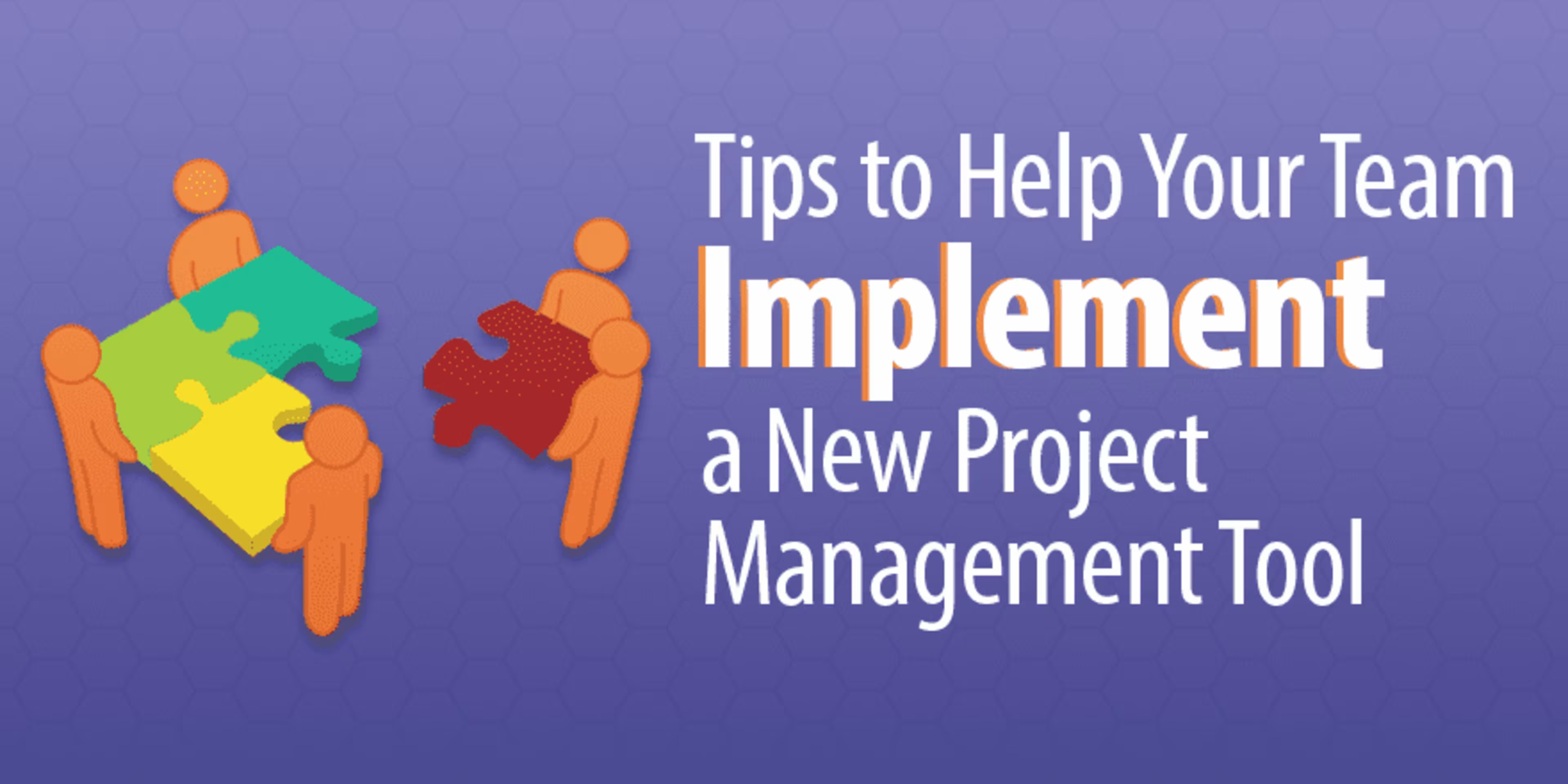Implementing company-wide change—particularly with large teams—is a monumental task that must be approached methodically, and thoughtfully.
Even within forward-thinking companies, resistance to change exists.
Getting your team on board with using a new project management tool is no different than asking them to adapt to other changes, and can be a difficult process.
Fortunately, there are a number of strategies you can use to turn technical skeptics into keen users.

You've done the research, compared and demoed a shortlist of project management tools, and have your new system in place. Time to relax, right? Not so fast.
Your new project management tool isn't doing your team any good if they're not using it.
We've got five steps to help you successfully implement a new PM tool, but before you can do so, you need to understand where your employees' resistance is coming from.
Deconstructing change resistance

You can't just throw a new PM tool at your team and expect them to play with it
Change and adaptability are essential components of an efficient workplace. Whether the changes affect your physical working environment or software system, transformation is necessary to keep your business moving forward.
These necessary changes, however, will inevitably meet resistance. Discussing resistance to change and effective change management for Harvard Business Review back in 1969, Paul R. Lawrence wrote that “what employees resist is usually not technical change but social change—the change in their human relationships that generally accompanies technical change."
What causes this social change, and how can we overcome or ease resistance to it?
In their 1948 study "Overcoming Resistance to Change," Lester Coch and John R.P. French Jr. found that employee participation was central to a smooth workflow transition. They introduced a new workflow to four groups of factory workers, each of which was instructed on or exposed to the change in a different way.
For example, the first group was simply told about the new workflow and asked to use it going forward. The fourth group was consulted on the issue that needed fixing, and collaborated on a new workflow to address the issue with their managers.
Unsurprisingly, the first group responded negatively, and suffered a drop in productivity and an increase in resignations. In comparison, the fourth group quickly adapted to the new workflow and recorded increased productivity.
While these examples are from several decades ago, the basic principles of change management haven't altered much since then.
We know that when the expertise of team members is respected and allowed influence, change resistance decreases. But, how can this theory be applied when introducing new project management software company-wide?
We spoke with a number of successful team leaders and project managers, who gave us the following five tips.
How to implement a new project management tool
1. Turn your managers into ambassadors

A friendly face makes change much easier to accept
The first step to software adoption is involving your management team(s). If your senior and middle managers are early adopters, they're much likelier to become avid change ambassadors.
Your ambassadors don't need to work in your IT department. In fact, it may be more effective if they're not IT professionals and can demonstrate the software's benefits in non-technical jargon.
To get your management team on board, you need to recognize that they each have existing workflows for their teams and project management. Alan Zucker, the founding principal of Project Management Essentials, says that this is one of the biggest challenges he sees when companies roll out new software.
In an environment without an existing enterprise tool, all layers of management and teams have their own, slightly different processes and points of view. When you migrate to a single enterprise application, all of these differences need to be resolved and aligned.
To facilitate buy-in, involve managers in the software selection process and ensure that their existing workflows can be modified to fit your new system. If your management team feels heard, they'll be more likely to train their own teams in a positive light.
Alexander Bekhterev, program manager at Emarsys, shared how this strategy aided his company's adoption of new project management software across a team of 750+, spread over 15 global offices:
The reason why most changes fail is because they are expressed once or twice but not modeled and reinforced by leaders or sponsors. We made sure that we not only told everyone in the company that there was a new tool coming but we modeled and reinforced that change on all managerial levels, top to bottom—all the way from global heads to front line managers.
When choosing your software ambassadors, hone in on good communicators who can effectively demonstrate and describe the tool's simplicity, as well as the immediate added benefit.
Stewart Small, founder of KTTP, shares how his company selects early adopters when introducing new software and products to client teams:
We seek out strategic early adopters: staff members that are not too technically savvy but are excellent communicators. We concentrate our efforts on first training these key influencers to act as a catalyst to encourage and train other staff members. This strategy works well because other members are far more motivated and confident when they see that less technically savvy team members have already mastered the platform.
To recap: identify your influencers and involve them in the decision and feedback process. The more ambassadors you have on board, the easier it is to roll out changes company-wide.
2. Demonstrate what's in it for your team

Costs down=good
What about everyone outside of management, though?
To get remaining team members on board, you need to successfully communicate what's in it for them.
Perhaps your current structure wastes time by requiring employees to gather information across various channels and tools. Explain that your new project management software will recover this lost time and prevent tasks from slipping between the gaps.
Demonstrate how the new software will help your team work smarter, not harder. Pending on company policies, you could also tout how an efficiency increase can prompt larger performance-based bonuses or less hours in the office (if you offer flexible working).
Susan Boles, a partner at business consultancy Grind/Revive, shares how this approach helped her company roll out large-scale ERP implementations:
The best implementations I've seen are ones where communication with the staff is prioritized. Explaining why new software is being implemented, what the benefits to everyone will be, [and] being clear about the timeline for implementation, are all key to getting staff on board and enthusiastic about the new software and process.
3. Provide software tutorials and set the rules

A literal sprint cycle
Once you've moved on to the training stage, your focus is on visually demonstrating the software's ease of use and associated benefits.
Speaking on how their international team of 450 members began collaborating using one project management tool, Torsten Schlautmann—head of HR, controlling, and administration at Opitz Consulting—shared that the simplicity and visual elements of the project management solution the company chose made onboarding easier, regardless of individual technical proficiency.
What we particularly like is the simplicity of use. Even our team members who were previously reluctant to use our IT systems were quick to onboard to our new collaborative tool. For example, our HR department all really love the tool, despite not being on our technical teams, as it's just so simple to use and quick to receive benefit[s] from.
Alan Zucker echoed that to demonstrate this benefit, it's useful to first walk team members through with a visual demo. “A project management system is primarily visual," he said. "People are much better at reacting to and providing feedback to something visual than written requirements."
When taking team members through your initial training, be sure you have a clear idea of how your company will specifically use the tool. Establish your company's workflows and use cases with management input, practice articulating them, and then train the rest of your team.
Alexander Bekhterev (program manager at Emarsys) notes:
Misalignment around project management app usage can mostly be avoided by creating rules, FAQs, and how-to documents, restricting rights, and by having limited amount of admins/moderators. We [management team] collaborated together during a few meetings and agreed on templates and project groups that would fit most of our use cases. Local admins were our source of knowledge in every office and helped employees use the product in the right way by educating them and solving issues when they arose.
4. Begin your onboarding with bite-sized tasks

Remember to take time to breathe between your bite-sized snacks, though
Despite receiving training, many staff members—particularly those less technically adept—will still find tackling new software daunting.
To combat this, start team members off on small tasks within the software, such as creating their profile or participating in a conversation. You can gamify the onboarding process so team members receive small rewards for their progress.
Stewart Small (founder of KTTP) shared the following:
Our most common hurdle was resistance to change, particularly with less technically savvy staff. To overcome these hurdles we have found that introducing new software is best done [in] small baby steps. Instead of introducing all aspects of the software at once, we limit it to a few simple function at a time. This gets staff used to the overall look and feel of the software and creates an increased level of confidence before we move on to any serious training.
Make sure the small tasks you assign are useful and demonstrate both the software's benefits and its functionality.
One example? Ask all team members to assign a task to their manager requesting information on their favorite tip or trick for using the new tool. This gets junior members using the new software while gaining valuable insight from an early adopter.
5. Open the door to feedback and listen

You don't need to look this devious while listening
Issues always arise during the early stages of implementation, and you want your team to let you know about them. To capture suggestions and create a positive feedback loop, run an internal staff survey one month after introduction, and again another three months in.
Team members will feel heard, and the process will (ideally) result in beneficial suggestions and use cases to improve your initial new software processes.
A simple survey will also help you assess the success of your onboarding efforts. Ask team members to rate, on a scale of one to five, how much they agree/disagree with the following statements:
I understand the changes proposed in the new strategy
With this new workflow, I know what is expected of me
I think the company is implementing its plans in line with our values
I know where to find out more information about the changes the company is making
I feel supported during this organizational change
I have the training I need to make this change effectively
These questions will measure your success at implementing the company-wide change, and provide a solid jumping-off point to ask specific questions about your new project management solution.
How have you championed change?
These are our five tips tips for introducing new project management software at your company; what are yours? What methods have you tried in the past? Where did you succeed, and where did you fail? Let us know in the comments below!
For further reading on implementing new project management software, check out these other articles on Capterra's project management blog:
Crafting Your Change Management Plan: A Beginner's Guide
6 Steps to Building A Bulletproof Business Case for Project Management Software [With Free Template]